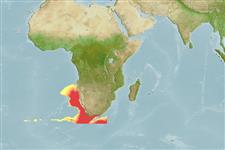>
Argentiniformes (Marine smelts) >
Microstomatidae (Pencil smelts)
Etymology: tenera: Named for its soft body (tenera = soft).
Eponymy: Fridtjof Nansen (1861–1930) was a Norwegian explorer, scientist, diplomat and later recipient of the Nobel Peace Prize. [...] (Ref. 128868), visit book page.
Environment: milieu / climate zone / depth range / distribution range
Οικολογία
Θαλασσινό(ά). Subtropical; 56°N - 39°S
Southeast Atlantic: Namibia (Ref. 27121) and South Africa (Ref. 26282).
Μέγεθος / Βάρος / Age
Maturity: Lm ? range ? - ? cm
Max length : 11.2 cm SL αρσενικό/απροσδιόριστο; (Ref. 5123)
Short description
Κλείδες προσδιορισμού | Μορφολογία | Μορφομετρία
Μαλακές ραχιαίες ακτίνες (συνολικά) : 11 - 12; Μαλακές εδρικές ακτίνες: 8 - 9; Σπόνδυλοι: 42 - 43. Branchiostegal rays 4. Pyloric caeca 7-9 (Ref. 5123).
Life cycle and mating behavior
Γεννητική Ωρίμανση | Αναπαραγωγή | Γεννοβολία | Αβγά | Γονιμότητα | Προνύμφες
Heemstra, P.C., 1995. Additions and corrections for the 1995 impression. p. v-xv. In M.M. Smith and P.C. Heemstra (eds.) Revised Edition of Smiths' Sea Fishes. Springer-Verlag, Berlin. (Ref. 11228)
IUCN Red List Status (Ref. 130435: Version 2024-1)
Threat to humans
Harmless
Human uses
Εργαλεία
Special reports
Download XML
Διαδικτυακές πηγές
Estimates based on models
Preferred temperature (Ref.
123201): 7.7 - 14.4, mean 10.2 °C (based on 36 cells).
Phylogenetic diversity index (Ref.
82804): PD
50 = 0.5000 [Uniqueness, from 0.5 = low to 2.0 = high].
Bayesian length-weight: a=0.00389 (0.00180 - 0.00842), b=3.12 (2.94 - 3.30), in cm total length, based on all LWR estimates for this body shape (Ref.
93245).
Τροφικό Επίπεδο (Ref.
69278): 3.3 ±0.4 se; based on size and trophs of closest relatives
Fishing Vulnerability (Ref.
59153): Low vulnerability (10 of 100).
Nutrients (Ref.
124155): Calcium = 47.1 [14.7, 143.2] mg/100g; Iron = 1.44 [0.56, 6.57] mg/100g; Protein = 3.38 [0.00, 7.17] %; Omega3 = 0.341 [0.152, 0.773] g/100g; Selenium = 31.1 [7.8, 88.0] μg/100g; VitaminA = 15.8 [5.2, 50.1] μg/100g; Zinc = 0.805 [0.417, 1.546] mg/100g (wet weight);
